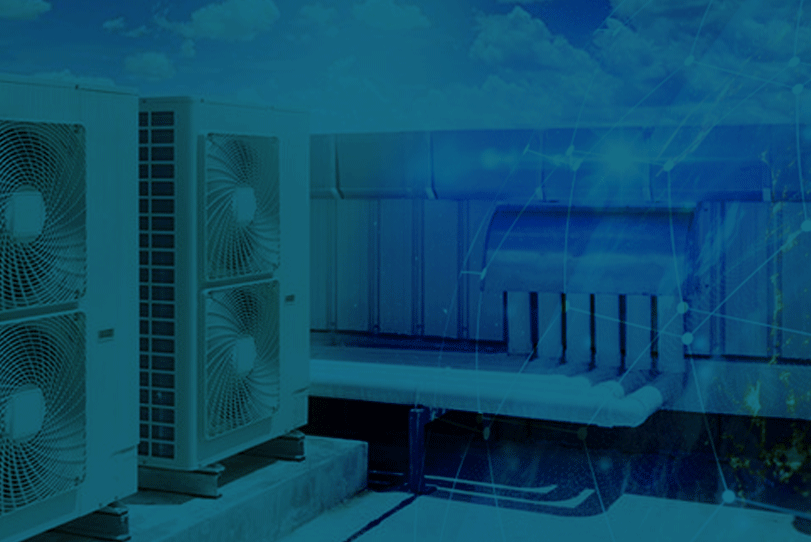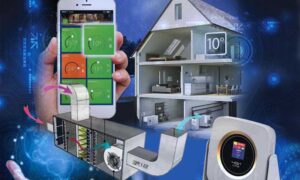Featuring some of the next generation HVAC technologies for public spaces.
-Subhajit Roy, Executive Editor
Heating, ventilating, and air-conditioning (HVAC) systems are an important part of any space such as residential, commercial and industrial buildings. As breathing quality air is becoming increasingly critical for human health and occupancy indoors, the need for maintaining indoor air quality (IAQ) is gaining significance. This report present to you what the industry experts have to say about the critical aspect of maintaining IAQ in indoor public spaces and buildings. They also talk about the steps to be undertaken to improve the ventilation and comfort in indoor public spaces and buildings.
Importance of maintaining IAQ in indoor public spaces and buildings
Sanjay Sudhakaran, Vice President – Digital Energy, Schneider Electric: Breathing pollution free and quality indoor air is critical for good health. Poor IAQ is a known contributor to a number of significant health problems with addition to increasing the rate of transmission for infectious diseases such as COVID-19, common cold, influenza and tuberculosis.
Buildings are the cornerstone of modern cities where we spend 75 percent to 80 percent of our time. IAQ is little complex and subjective. IAQ is a constantly changing interaction of complex factors that affect the types, levels and importance of pollutants in indoor environments. These factors include: sources of pollutants or odours; design, maintenance and operation of HVAC systems; moisture and humidity; and occupant perceptions and susceptibilities. In addition, there are many other factors that affect comfort or perception of IAQ.
The management of IAQ can significantly reduce the health hazards in indoor public spaces and buildings created by inadequate HVAC function. Improved airflow control can be provided without energy penalties, simply by gaining more precise control over ventilation rates. A dynamic, continuously adjusting system will provide the greatest health benefits and flexibility.
Daniel Chen, CAREL APAC Marketing Manager (HVAC): IAQ refers to the properties of air inside buildings, in relation to how these affect human health and occupancy indoors. Indeed our health, behaviour and all-round wellbeing are dependent on indoor conditions inside buildings. Some of the most relevant parameters that contribute to a general sensation of comfort are: Temperature, relative humidity, air speed, CO2 concentration, Volatile Organic Compound (VOC) concentration, and micro-organism concentration.
When these parameters are outside of certain limits, the human body suffers. Symptoms may vary greatly: headache, dizziness, nausea, eye, nose or throat irritation, dry cough, dry or itchy skin, difficulty in concentration, fatigue, sensitivity to odours, hoarseness of voice, allergies, cold, flu-like symptoms, increased incidence of asthma attacks.
For example, a suitable level of relative humidity prevents excessive skin, eye and respiratory tract dryness and enables us to breathe and perspire more easily. We can thus avoid overloading our body’s thermoregulation system and consequently causing discomfort. Other symptoms caused by breathing excessively dry air are headache, fatigue and irritability.
Managing humidity correctly also makes it possible to reduce any dust particles in the air by making them adhere to walls and floors. In a dry environment, they would remain suspended for longer, accentuating the feeling of dryness and discomfort.
Relative humidity also affects the health of building occupants in other ways, through its impact on infectivity and indoor transmissibility of bacteria and viruses. Several laboratory studies have found that some airborne-transmitted viruses – example influenza virus – sharply decrease their activation rate at relative humidity above 40 percent.
Rahul Aeron, Assistant Vice President, Sales, DRI – Pahwa Group: Human being spends almost 80-90 percent of their time indoors. Most of these buildings whether offices, homes or even cars, are air conditioned. Studies have shown that indoor air is almost 8 to 10 times more polluted than outside air, the risk to health is much greater indoors than outdoors.
There are 2 major reasons for maintaining good IAQ: Health benefits and economic benefits.
IAQ is affected by microbial contaminants (mold, bacteria), gases (carbon monoxide, radon, VOCs), particulates or any other ingredient that can induce adverse health conditions, starting with SBS (Sick Building Syndrome) and eventually building up to BRI (Building Related Illnesses). Indoor air is therefore becoming a more concerning health hazard and can be improved by using ventilation to dilute contaminants, filtration and have pollutant source control.
Further, good IAQ leads to better productivity. A well designed building creates healthier environment and comfort for people to live and work using improved IAQ, natural daylight and thermal comfort and also saves money from an energy usage perspective.
Raghavan, Director, Channel Sales, Johnson Controls (I) Pvt Ltd: COVID-19 has increased the awareness of the importance of IAQ. Occupants need to feel safe as they enter a building, trusting that the air is not contaminated and that they will not be infected. Even before COVID-19, we know that IAQ directly affects the health of people and their performance. A lot of research has gone into understanding the impact of different IAQ parameters such as thermal comfort, fresh air supply, dust level control, microbial concentration in air stream by organizations like Indian Society of Heating, Refrigeration and Air Conditioning Engineers (ISHRAE), American Society of Heating, Refrigeration and Air Conditioning Engineers (ASHRAE), Centers for Disease Control and Prevention (CDC), Environment Protection Agency (EPA) etc., who have published guidelines for public spaces and buildings. By expanding the scope of IAQ, with inclusion of guidelines on lighting and sound level in occupied space, the HVAC industry in India has started focusing on IEQ (Indoor Environment Quality) now. Still a lot of work has to be done in the many thousands of already existing buildings to improve IEQ.
Steps to improve ventilation and comfort in indoor public spaces and buildings
Sanjay Sudhakaran: In the past, thermal properties of air within a zone determined HVAC specifications. Currently, occupant-specific and highly responsive systems are the norm. Natural ventilation, displacement ventilation, micro zoning with subfloor plenums, along with the use of point of source heat control and point of use sensors, is evolving to create a “smart” responsive ventilation-building dynamic system.
It is important to also maintain the correct flow of air from clean to less-clean. You should consider monitoring and trending of pressure and air flow rates, including room-level monitoring if there is a need for internal zone differential pressure.
In support of better predictive maintenance, pressure sensors can be used to monitor the pressure drop caused when filters need replacing. IAQ should also be monitored. Dust can act as a vehicle for viruses that become aerosolised. PM2.5 or PM10 monitoring devices should be considered for monitoring whether levels of particulate are being adequately reduced. VOCs can also have a negative impact on occupant health. IAQ monitoring systems can be used to monitor and log VOC levels.
Occupancy levels will be important to monitor. This will help comply with guidelines set by local authorities, and to keep occupants safe. Simple tracking by access control systems may be enough, or it may be necessary to monitor different areas in a building, from meeting rooms and cubicles to communal areas, such as cafeterias and gyms.
Daniel Chen: Modern buildings are increasingly airtight, and thus their indoor air conditions are mostly determined by how well the HVAC system works and caters to the needs of the human body. Therefore, IAQ is a key factor in the correct design of HVAC systems in modern buildings.
There are various national and international guidelines that regulate the allowable range for each parameter, although these are not mandatory in most countries.
For example, temperature is usually required to be between about 67- and 82-degree F or 20- and 27-degree C across the year, relative humidity between 40 and 60 percent, and indoor CO2 level lower than 1,000 ppm.
The supply of fresh air into indoor spaces also plays a crucial role in people’s health. Not only is the right temperature and humidity essential, but even more so the purity of the air we breathe.
Rahul Aeron: The minimum ventilation rate in buildings is designed as per ASHRAE standards 62.1. However, in most of the buildings while a provision is provided for bringing in the outdoor or fresh air, the high ventilation load pushes the operation manager to turn off the fresh air. A simple solution to this problem is introduction of Energy Recovery devices, which pre-cools the hot and humid outdoor air while using the cooling energy of stale or exhaust air.
This also helps in maintaining comfort inside the building as the designed air conditioning system will have the capability to handle the loads of pre-cooled outside air.
Raghavan: To improve the IAQ in indoor public spaces and buildings, one should begin by measuring parameters like zone temperature, % RH, CO2 level (inverse measure for oxygen), PM2.5, TVOC and microbial presence. These values should then be benchmarked against published standards (e.g. ASHRAE standard 55 for Thermal comfort and ASHRAE 62.1 for Ventilation). Finally an improvement plan needs to be charted out.
U.S. Green Building Council (USGBC) and Indian Green Building Council (IGBC) recommend facility teams to take “qualitative feedback” from the occupants to determine the comfortable temperature for a space, rather than strictly sticking to a “fixed” set point. This can be done through a user-friendly mobile app to collect a real-time feedback from the occupants, upon which the set point of the HVAC system can be automatically adjusted. Deployment of enabling technology to allow this is neither difficult nor expensive.
In the current pandemic environment, simply adding good quality filters in the HVAC equipment and installing high intensity Ultra Violet Germicidal Irradiation (UVGI) lamps is highly effective in containing airborne transmission of infection. ASHRAE and ISHRAE strongly recommend use of UVGI lamps in HVAC equipment in high traffic space like cafeteria, shopping malls, hotels, cineplex, metro stations, metro trains, airports, etc.
We also see an increasing need to collect more data to make better decisions through digital transformation. What we are observing from our global portfolio of 1,500 buildings in OpenBlue Enterprise Management is the urgent need for a better balance between clean air and energy savings. COVID-19 has caused a significant reduction of people going to their workplaces, so businesses are consolidating their office space and concentrating their employees in smaller areas to reduce energy use. As a result, some offices have increased that CO2 levels to 2,000 ppm. This is above the industry standard of 1,000 ppm maximum and studies have shown that every additional 400 ppm correlates with 20 percent drop in productivity. Businesses need data to strike a balance between clean air and energy efficiency and they need data and expertise to do proper zoning for optimal results.
Futuristic HVAC solutions for indoor public spaces and buildings
Sanjay Sudhakaran: As part of our series on preparing commercial buildings for a return to the workplace, we’ve experienced how smart building technology can help our customers operate more efficiently and effectively under the ‘new normal’. To sustain occupant well-being, building conditions should be continuously measured and BMS controls adjusted as necessary. We also need to take into account balancing IAQ and comfort against energy efficiency and costs.
Once again, the newest smart building technologies and services from Schneider can help to simplify these requirements for healthy buildings. We are the preferred technology partners in indoor public places and buildings, and it’s because at Schneider Electric, we make buildings digital – because digital enables amazing occupant experiences and drives efficiency across your portfolio. We have achieved this using EcoStruxure – our IoT architecture. EcoStruxure is an open, globally consistent, end-to-end, cyber secure, digital innovation platform which encompasses a broad range of services including workplace IoT analytics, intuitive HVAC control enhancement, advanced energy management, and cloud-powered microgrid orchestration. Clients who have used the EcoStruxure platform have achieved some amazing business outcomes including an increase in tenant satisfaction of 33 percent, an increase in Net Promoter Score of 16 percent, a drop in energy costs of 30 percent while overall maintenance costs have fallen as much as 50 percent. Overall we drive the occupant wellbeing within the public spaces and buildings by creating optimal humidity, fresh air circulation and rise of VOC.
Using our solution, customers can set capacity thresholds for room, floor or building level to know when the occupancy is exceeding limits and analyse how occupants are using individual and collaborative spaces and then adjust the workplace mix.
Daniel Chen: An air handling unit control and automation system can play a vital role in ensuring the correct personal comfort and health conditions are maintained in occupied rooms. The control system coordinates all of the unit’s components, which work together to achieve the desired ventilation with the lowest possible energy consumption.
CAREL offers ready-to-use solutions that implement advanced logic to ensure that the right quantity and quality of air is introduced into rooms, when needed. Demand-controlled ventilation logic based on multiple parameters (CO2, VOC, PM 2.5-10), room pressurisation management, monitoring of absolute filter (HEPA) clogging, and advanced control of adiabatic humidification are fundamental strategies in achieving these goals.
The CAREL smart AHU solution can ensure that the air handling unit operates in compliance with the most stringent hygiene standards, such as VDI6022, avoiding the unit itself from representing a risk for the spread of bacterial contamination.
High-pressure spray humidifiers can provide the correct level of humidity by delivering tiny droplets of water directly into the air flow. Their energy consumption is very low (just 4W for each litre of atomised water). CAREL offers cutting-edge technology for high-pressure adiabatic humidifiers through the humiFog family.
Heat recovery is an essential component of ventilation systems in commercial environments. No contamination between the intake and exhaust air flows, resistance to corrosion and materials that prevent the spread of bacteria are all requirements for the correct choice of components. With the CAREL Group’s acquisition of RECUPERATOR, we can now count on a wide range of plate or rotary air-air heat recovery units, suitable even for the most stringent applications in terms of hygiene and performance.
Remote control technologies can continuously monitor the quality of the air supplied by the air handling unit and verify any deviations between ideal and actual conditions, allowing immediate action in the event of malfunctions and a prompt response to emergency conditions. CAREL has a portfolio of products and services for local and remote supervision of HVAC systems, simplifying control, maintenance and optimisation of operation, wherever they are located.
Rahul Aeron: DRI has been at the forefront of technologies, especially at the air side of HVAC systems. We were the first to introduce enthalpy wheel and treated fresh air units incorporating enthalpy wheel.
Presently a lot of focus on air side is by reducing the fan power which can be easily achieved by designing buildings with chilled beam system. DRI is the first Indian company to start the manufacturing of chilled beam systems in India.
Also, in most of the building Relative Humidity (RH) remains a major design issue. DRI Dedicated Outdoor Air Systems (DOAS) helps to maintain recommended RH in the building using patented technology of passive dehumidification.
DRI is also India’s first manufacturer to introduce DOAS with the complete refrigeration system on board. These systems utilise waste heat of condenser to re-generate desiccants thereby allowing the building to be designed at higher chilled water temperature.
Raghavan: What we are observing from our global portfolio of 1,500 buildings using our OpenBlue Enterprise Management system is an urgent need for better balance between clean air and energy savings. These lamps are available with different fixtures that make installation easy in any type of HAC equipment like AHU, FCU, ducted AC, packaged AC, high-wall split AC or cassette AC.
The MERV-14 grade ESP filters from Johnson Controls deliver PM2.5 (2.5 micron dust level) control with 95.5 percent efficiency. These are made of aircraft grade alloy steel and are highly durable, with no bi-annual ‘filter replenishment cost’, unlike that of conventional filters which we are currently accustomed to. The collector plates, where the fine dust settles down are washable and an electronic panel gives an alarm whenever it is time to dust-off the collector plates.
The stand-alone Room Air Sterilizer from Johnson Controls, deploying ESP + UV technology is ideal for classrooms, library, restaurants etc. to provide a “safe space” for users. Johnson Controls mobile HEPA units can help to convert a hospital general ward into isolation wards, by maintaining negative pressure inside. These units purify and disinfect the exhaust air stream using a H13/14 grade HEPA filter + UVGI combination, so that the neighbourhood is not infected.
Quotes
The management of IAQ can significantly reduce the health hazards in indoor public spaces and buildings created by inadequate HVAC function.
Sanjay Sudhakaran, Vice President – Digital Energy, Schneider Electric
In the current pandemic environment, simply adding good quality filters in the HVAC equipment and installing high intensity UVGI lamps is highly effective in containing airborne transmission of infection.
Raghavan, Director, Channel Sales, Johnson Controls (I) Pvt Ltd
Indoor air is becoming a more concerning health hazard and can be improved by using ventilation to dilute contaminants, filtration and have pollutant source control.
Rahul Aeron, Assistant Vice President, Sales, DRI – Pahwa Group
Modern buildings are increasingly airtight, and thus their indoor air conditions are mostly determined by how well the HVAC system works and caters to the needs of the human body.
Daniel Chen, CAREL APAC Marketing Manager (HVAC)
Cookie Consent
We use cookies to personalize your experience. By continuing to visit this website you agree to our Terms & Conditions, Privacy Policy and Cookie Policy.














